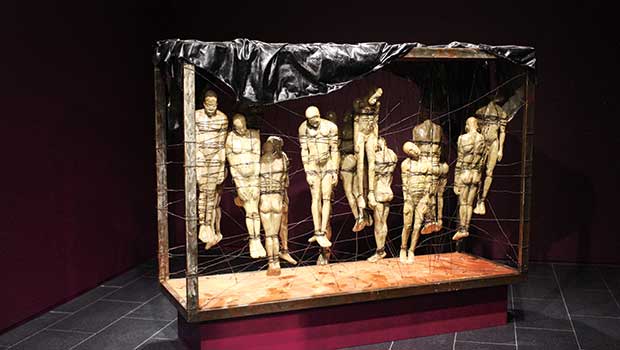An archive of their own
Wole Soyinka collection takes back African representation

“WOLE SOYINKA: Antiquities Across Times and Place,” on view at the Ethelbert Cooper Gallery of African and African American Art in Harvard Square, features nearly three dozen objects from the famous African playwright’s personal collection. Contemporary works by Nigerian artists who have been inspired by Soyinka’s writing augment his personal pieces. The resulting exhibition presents a dynamic response to the question, “What does it mean when artists collect art?”

Author: Celina ColbyWole Soyinka’s collection, on display at Harvard’s Cooper Gallery, features works by
contemporary Nigerian artists.
On the Web
on the web
For more information about WOLE SOYINKA collection, visit: www.coopergalleryhc.org.
Soyinka largely chose the pieces from his own collection, and curator Awam Amkpa, an NYU professor and former student of Soyinka’s, put together the contemporary works. “I looked for artists who were using the same aesthetic vocabulary,” he says. “It’s not art for art’s sake. These objects have community significance.” Soyinka’s collection has a strong emphasis on Yoruba art objects, which often bear a religious significance and function.
Throughout the exhibit, quotes from Soyinka open a window into his collecting practices. In one of these excerpts he says that his eyes weren’t opened to the pilfering and repatriation of African art objects by other nations until he returned from studying in the United Kingdom in 1960. Then, he says, “Out of resentment for centuries of robbery, I began to collect – collect in inverted commas, in deference protection to the real collectors.”
The contemporary works reflect this history of stolen culture. Osaretin Ighile’s piece “Oba Ovonramwen” features a sculpture in metal and wood of Ovonramwen, the last independent king of Benin, Nigeria, where the artist is from. The figure of the king himself looks like one of the ancient sculptures, but Ighile has draped the seated statue in colorful reclaimed plastic. The bits of crates and plastic bags make a draped garment for the king out of what is essentially garbage.
In 1897, Ovonramwen was forced to surrender to the encroaching colonialism of Britain and lost the kingdom to them. Ighile’s piece reflects the European treatment of ancient African objects. They were looted and appropriated for white museumgoers and patrons to gawk at, while lost to the people for whom they bore civic and religious significance. Ighile’s “Oba” also wears a metal cuff around his neck, attached to a chain. He, and the art, is captive and cast off.
Amkpa says he was most surprised by the inclusion in Soyinka’s pieces of a spiritual mask from the Congo. A sharp contrast to the Yoruba works, the “Kuba Kete Mask” features an elongated face and neck with wide eyes and tight lips. Whereas many of the Yoruba works have open but not engaged eyes, the “Kuba” head appears to be staring directly at you, haunted by what it sees.
For Soyinka, art collection is a means of taking back control. The exhibition is an African representation that he has built himself. Amkpa says, “For Africans that are always being archived by others, this is an opportunity to make an archive of their own.”







